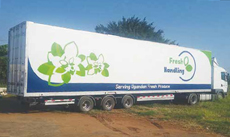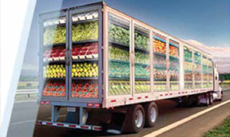 The cut flower industry in Kenya is a thriving sector, with the country being one of the leading exporters of fresh flowers worldwide. The journey of these delicate blooms from Kenyan farms to international markets is a complex and delicate process, where maintaining the cold chain is of paramount importance. This entails the use of temperature-controlled vehicles to ensure that flowers are transported at optimal conditions.
The cut flower industry in Kenya is a thriving sector, with the country being one of the leading exporters of fresh flowers worldwide. The journey of these delicate blooms from Kenyan farms to international markets is a complex and delicate process, where maintaining the cold chain is of paramount importance. This entails the use of temperature-controlled vehicles to ensure that flowers are transported at optimal conditions.
The Importance of Temperature- Controlled Vehicles
Cut flowers are highly perishable, and their quality and shelf life are greatly affected by temperature fluctuations. To preserve their freshness and prevent wilting, it is essential to transport them in temperaturecontrolled vehicles, often referred to as refrigerated trucks or reefer trucks. These vehicles maintain a consistent and controlled environment, ensuring that the flowers remain at the ideal temperature and humidity levels throughout the transportation process.
Challenges in Flower Transportation
1.Temperature Variations
One of the primary challenges in flower transportation is maintaining the ideal temperature. Temperature fluctuations during transit can lead to the flowers wilting, which significantly reduces their market value. Kenya’s flower industry relies heavily on exports, and flowers may travel long distances to reach their destination. Ensuring a stable temperature throughout the journey is essential.
2. Logistics and Infrastructure
Kenya’s infrastructure and logistics capabilities are not always well-suited to the needs of the flower industry. Inadequate roads, traffic congestion, and delays in customs clearance can disrupt transportation schedules, potentially leading to temperature deviations.
3. Energy Costs
Running and maintaining temperaturecontrolled vehicles can be expensive, especially when considering the need for fuel or electricity to power refrigeration units. High energy costs can cut into profit margins for flower growers and exporters.
 4. Environmental Concerns
4. Environmental Concerns
The flower industry, like other sectors, is under increasing pressure to reduce its environmental impact. The use of refrigerated vehicles may contribute to greenhouse gas emissions and can be seen as an environmental concern.
Solutions in Flower Transportation
1. Advanced Temperature Monitoring and Control Systems
Innovation in temperature monitoring and control systems has been crucial in addressing temperature variations during flower transportation. Modern reefer trucks are equipped with state-of-the-art temperature sensors and control systems. These systems provide real-time monitoring and enable remote adjustments, ensuring that the flowers are transported at the desired temperature
2. Pre-cooling Facilities
Pre-cooling is the process of lowering the temperature of flowers before they are loaded onto transportation vehicles. It is a critical step in maintaining the cold chain. Precooling facilities in close proximity to flower farms help ensure that flowers start their journey at the optimal temperature. This reduces the strain on the reefer trucks during transportation.
3. Improved Logistics and Infrastructure
Efforts to improve the logistical aspects of flower transportation are ongoing. Investments in better road infrastructure, more efficient customs clearance processes, and coordination between different stakeholders in the supply chain all contribute to smoother flower transportation. Some flower farms have also developed their own dedicated logistics teams to ensure efficient transportation.
4. Sustainable Energy Solutions
To address the challenge of high energy costs and environmental concerns, the flower industry is exploring sustainable energy solutions for temperature-controlled vehicles. Some companies are transitioning to electric or hybrid refrigeration units, which reduce both operational costs and environmental impact.
5. Collaboration and Information Sharing
Collaboration and information sharing within the industry are vital to overcoming transportation challenges. Flower farms, logistics companies, and exporters are increasingly sharing data and insights about transportation routes, best practices, and challenges. This collaborative approach helps the industry as a whole to improve transportation efficiency.
6. Continuous Training and Education
Ensuring that all stakeholders in the flower transportation process are well-trained and educated on best practices is essential. Training programs and workshops are and other personnel how to operate and maintain reefer trucks, as well as the importance of the cold chain in preserving flower quality.
Innovative Reefer Truck Technologies
1. Smart Reefer Trucks
The introduction of smart reefer trucks has brought a new level of control and monitoring to flower transportation. These trucks are equipped with advanced sensors and connected systems that allow for real-time tracking of temperature, humidity, and other environmental factors. They can send alerts and data to a centralized control center, enabling immediate intervention in case of deviations.
2. Dual Temperature Zones
Dual-temperature zone reefer trucks are designed to carry different types of flowers with varying temperature requirements in a single trip. This innovation reduces the need for separate transportation for each flower variety, streamlining the supply chain and reducing transportation costs.
3. Energy-Efficient Refrigeration Units
Reefer truck manufacturers are focusing on developing energyefficient refrigeration units. These units consume less fuel or environmental impact. Energy-efficient technologies include electric standby options and advanced insulation materials.
 4. Autonomous Transportation
4. Autonomous Transportation
While still in the experimental phase, autonomous or selfdriving reefer trucks have the potential to revolutionize flower transportation. These vehicles can operate 24/7 without the need for rest breaks, increasing efficiency and reducing transportation times. However, regulatory and safety concerns need to be addressed before widespread adoption.
Impact of Solutions on the Flower Industry
1. Improved Flower Quality
The implementation of advanced temperature monitoring and control systems, as well as pre-cooling facilities, has significantly improved the quality and shelf life of Kenyan flowers. Customers receive fresher, longerlasting blooms, enhancing the reputation of Kenyan flower exports.
2. Market Access and Growth
Efforts to improve logistics and infrastructure have expanded market access for Kenyan flower exporters. The industry can reach more distant markets, increasing revenue and driving growth. Improved transportation logistics also reduce the risk of flowers missing their scheduled flights or ships.
3. Reduced Costs and Waste
Sustainable energy solutions and energy-efficient refrigeration units have reduced operational costs for flower transportation. Additionally, dual-temperature zone trucks have streamlined the supply chain, minimizing waste and cost associated with separate shipments for different flower varieties.
4. Environmental Responsibility
Transitioning to sustainable energy solutions and reducing energy consumption in reefer trucks align with the flower industry’s commitment to environmental responsibility. As consumers become more eco-conscious, this commitment can improve the industry’s reputation and marketability.
Challenges and Solutions: A Global Perspective
The challenges and solutions discussed in this article are not unique to Kenya’s flower industry but are applicable to the global flower trade. The transportation of cut flowers is a complex process, and the industry faces similar issues in maintaining the cold chain, regardless of location. Innovations in temperature-controlled vehicles and transportation processes can benefit flower industries worldwide.
The transportation of cut flowers from Kenyan farms to international markets is a complex and delicate process that relies heavily on temperature-controlled vehicles. Challenges such as temperature variations, logistics, energy costs, and environmental concerns have driven the development of innovative solutions within the flower transportation sector.
Advanced temperature monitoring and control systems, pre-cooling facilities, improved logistics, sustainable energy solutions, collaboration, and education have all played a role in enhancing the quality and shelf life of Kenyan flowers, expanding market access, reducing costs and waste, and demonstrating environmental responsibility.
As the flower industry continues to grow and adapt to changing consumer demands, the evolution of flower transportation solutions will be crucial in maintaining Kenya’s status as a key player in the global cut flower market. With continued innovation and collaboration, the industry is poised for a bright and sustainable future.


